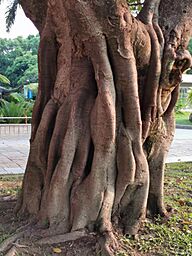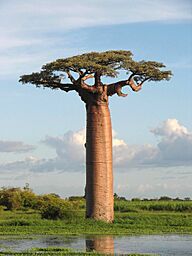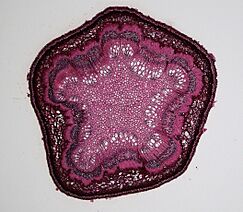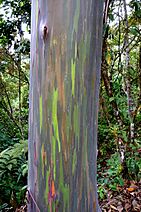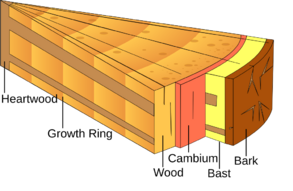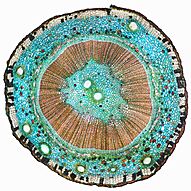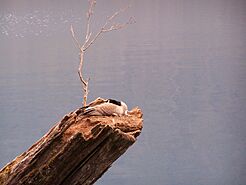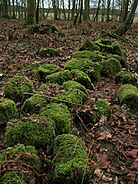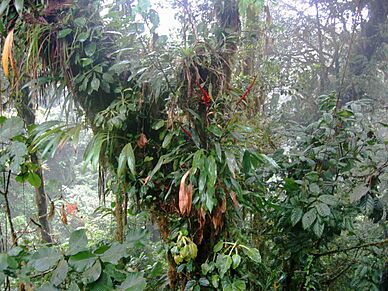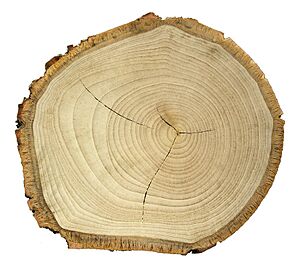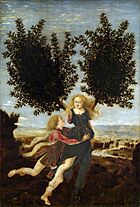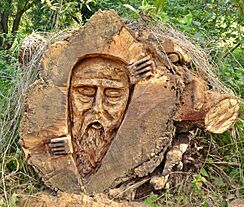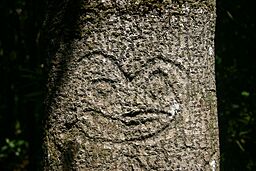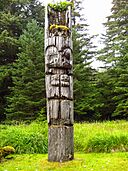Trunk (botany) facts for kids
A trunk is the main stem of a tree or other woody plant. It's like the tree's backbone, giving it strength and helping it stand tall. The trunk is made of different parts, each with a special job.
Inside, there's the heartwood, which is dead wood but super strong, giving the tree its main support. Around that is the sapwood, which is alive and helps move water and nutrients up to the leaves. It also stores food for the tree.
Between the wood and the bark is a thin layer called the cambium. This is where the trunk grows wider each year. The bark is the outer layer. It has an inner part (the phloem) that carries sugars made in the leaves to other parts of the tree. The outer bark is a tough, dead layer that protects the tree from damage and diseases.
Trees have special ways to grow and to fix themselves if they get hurt. Trunks are built to handle strong winds, staying stiff and strong. If a trunk gets damaged, it has a slow but clever way to heal. It creates a barrier to stop diseases from spreading and then grows new, healthy cells to replace the damaged ones.
Trunks are important for living trees, but they also play a big role after a tree dies. Dead trunks, called coarse woody debris, become homes for animals and plants. They also help recycle nutrients back into the soil and control how soil and sediment move. Most trees outside tropical areas show their age through annual rings inside their trunks. These rings can even tell us about past climates! People have used tree trunks for thousands of years to build things, make medicines, and create many wooden products. Trunks also have a special place in many cultures, appearing in stories, art, and traditions.
Contents
What Kinds of Plants Have Trunks?
All vascular plants have roots and stems. But only certain types of plants grow trunks. These include gymnosperms (like pine trees) and some flowering plants called dicots (which have two seed leaves when they sprout). Other plants, like bamboo or flax, are called herbaceous plants. They don't grow trunks.
How is a Tree Trunk Built?
A tree trunk connects the roots underground to the branches, canopy, and leaves above. The main parts of a trunk are the heartwood, sapwood, cambium, inner bark, outer bark, and the pith.
The xylem, or wood, is separated from the bark by the cambium. The cambium helps the tree grow wider. The younger part of the xylem, the sapwood, carries water from the roots to the leaves. It also stores food. The heartwood is the darker, older wood in the center. It's completely dead but gives the tree its main strength. The pith is a tiny part in the very center, left over from when the stem was young.
The main reason trees grow trunks is to become taller and more stable. This helps them reach sunlight and spread their leaves.
When you look at a tree trunk cut across, you often see tree rings. These rings show how much the tree grew each year. Wood grown early in the season (earlywood) is less dense than wood grown later (latewood). This difference creates the rings. In most places, each ring means one year of growth. However, near the equator, trees might not have clear annual rings because the climate doesn't change much throughout the year.
Bark: The Tree's Protective Skin
The bark is the tree's outer layer. It has an inner part called the phloem, which moves sugars around the tree. The outer part of the bark is dead and protects the trunk from harm and from losing too much water. You might see small holes in the bark called lenticels. These are like tiny pores that let the tree breathe, allowing gases like carbon dioxide and oxygen to pass through.
How Do Trunks Grow?
Tree trunks grow in two main ways:
- Primary growth makes the tree taller. This happens at the very tips of the stems and branches.
- Secondary growth makes the trunk wider. This happens in the cambium layer.
The cambium is a thin layer, only a few cells thick. These cells divide to create new wood (xylem) on the inside and new bark (phloem) on the outside. This division is what makes the trunk grow thicker over time.
Sometimes, if a tree grows on a slope or leans, it creates special wood called reaction wood. This wood helps the tree stay upright. In some trees, it's called tension wood, and in others, it's compression wood, depending on how the tree reacts to the lean.
How Hormones Affect Growth
Tiny chemical messengers called plant growth hormones control how and when a tree grows. For example, a hormone called Auxin helps the tree grow taller by making the main tip grow more, while stopping side buds from growing too much. Other hormones also play a role in how the trunk gets wider and how many wood and bark cells are made.
How Trunks Heal Wounds
If a tree trunk gets hurt, like from a cut or a scrape, it creates a wound. This wound can let in pathogens (germs that cause disease). To protect itself, the sapwood creates a barrier of discolored wood. This wood contains special molecules that stop the germs from moving further into the tree. If the germs try to break through, the tree might plug up its water-carrying tubes or make thicker cell walls to block them. Healing a wound is a complex process, but eventually, the tree produces new tissue that turns into new cambium cells, helping to seal the injury.
How Trunks Handle Forces

Wind is a big challenge for trees. It creates forces that can cause the trunk to bend, stretch, or even vibrate. Trees have adapted over time to resist these forces and avoid breaking.
Wood is a unique material. It's not perfectly springy like a metal, nor perfectly fluid like water. It's somewhere in between, which helps it handle stress. Also, wood isn't the same in all directions because of how its cells are arranged. This makes it very strong but also complex to study.
To understand how trunks resist wind, scientists often simplify their structure. They might think of wood as a composite material, where strong fibers carry most of the load. Or they might look at the tiny cell structure and how each cell contributes to the trunk's strength.
Trunk Strength and Properties
Generally, the thicker and denser a trunk is, the stronger and stiffer it will be. This means it can resist bending and breaking better. When trees are exposed to wind or other physical forces, they change their growth to become stronger. They often increase their radius (get thicker) to become stiffer.
The points where branches meet the trunk are usually the weakest spots because of the way the wood grows there, forming what are called knots. The bark itself doesn't add much to the trunk's stiffness, but it's crucial for protection.
How Trunks Handle Wind and Vibrations
When strong winds blow, trees can start to sway and vibrate. There's a risk that they might vibrate at a "resonant frequency," which could cause branches to break or even the whole tree to fall over. Trees have a clever way to prevent this: they transfer the energy of the vibrations away from the main trunk and into the smaller branches and twigs. This helps to dampen, or reduce, the swaying without making the tree bigger and more exposed to the wind.
Trunks and Nature
Living tree trunks are a vital part of the natural world. They provide structure and nutrients, supporting many plants and animals. For example, epiphytes are plants that grow directly on tree trunks, and many invertebrates and animals use trunks for shelter or food.
What Happens When Trunks Die?
When a tree dies, its trunk becomes coarse woody debris (CWD). This can be a standing dead tree, a fallen trunk, or large branches. CWD is incredibly important for the environment. It provides habitats (places to live) for many animals, helps new plants grow, and plays a big role in nutrient cycling.
CWD breaks down in several ways, returning nutrients to the soil. Water can wash minerals out, animals and plants can break it into smaller pieces, and tiny microbes can decompose it. Many factors affect how fast CWD breaks down, like temperature, moisture, and the types of organisms present. Dead trunks store a lot of carbon and nutrients, making them a key part of the ecosystem.
CWD also acts as a living surface for many types of plants, algae, and bacteria. These include lichens, ferns, and even new trees. CWD can offer a place to grow, nutrients, shade, and even stop soil from washing down hills.
Many animals use CWD as a home. Birds, bats, reptiles, amphibians, and even fish use dead trunks for shelter, finding food, raising their young, resting, or hibernation. The size and shape of the CWD can affect how animals use it.
Dead trunks also impact the landscape. Uprooted trees can mix and enrich the soil. Fallen logs can block the movement of soil and water down hills. In rivers, CWD can change the shape of the waterway and help store sediment.
How Do We Know a Tree's Age?
We can tell how old a tree is by counting its annual rings in the trunk. This is called dendrochronology. Each ring usually means one year of growth, except for trees in certain environments like near the equator.
Scientists can also study these rings to learn about the climate the tree lived in. This is called dendroclimatology. The width of the ring and the density of the latewood can tell us about past summer temperatures. Wider rings and denser latewood often mean warmer summers.
What Are Trunks Used For?
People have used tree trunks for thousands of years. Wood from trunks is used for building homes and making countless products, including paper. It's a strong and sustainable building material because it grows naturally. Trunks are also used as wood fuel for heating, generating power, and making charcoal.
Trees also produce useful substances like resins, which can be used in products like varnishes. The bark of different trees has many uses too. For example, the bark of the Cinchona tree has properties that help fight malaria. Other barks are used for making fire extinguisher foam, dyes, or cork (from the Quercus suber tree). Many other parts of trunks and barks are used in traditional medicine. Some trees even produce latex, which is used to make rubber, a flexible and waterproof material.
Trunks in Culture
Tree trunks appear in many cultures as symbols, in rituals, and in folk beliefs. They are also used in art and crafts. The idea that trees represent eternal life might come from seeing new growth sprout from old trunks. Because tree trunks and branches can look a bit like human bodies, they sometimes represent fertility in different cultures.
In some parts of North America and Africa, people perform symbolic "marriages" with trees by touching them for a long time. In India, ceremonial marriages are held between different tree species or between people and trees for various ritual reasons. In Greek mythology, humans and nymphs are often turned into trees for protection, like Daphne who became a laurel tree.
The way tree trunks and branches connect is often used as a metaphor in language, like in "family trees" or "branches of knowledge". Trunks are very important to many indigenous peoples, both for their spiritual meaning and for the resources they provide. For example, the Mbuti people of the Democratic Republic of the Congo make special ritual clothing from tree bark. The Warlpiri people of Australia believe that human souls come from the trunks of trees at birth.
Tree trunks are also widely used to make canoes and totem poles, like those created by peoples in the Pacific Northwest. On the Chatham Islands of New Zealand, the Moriori people carved special designs called arborglyphs into the trunks of Corynocarpus laevigatus trees.
See also
 In Spanish: Tronco (botánica) para niños
In Spanish: Tronco (botánica) para niños


